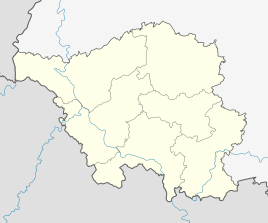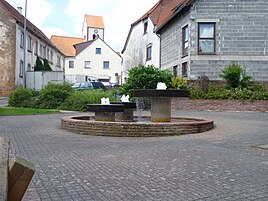Niederbexbach
|
Niederbexbach
City of Bexbach
|
||
|---|---|---|
| Coordinates: 49 ° 19 ′ 56 ″ N , 7 ° 15 ′ 49 ″ E | ||
| Height : | 262 m | |
| Area : | 5.73 km² | |
| Residents : | 1119 (Jan. 1, 2020) | |
| Population density : | 195 inhabitants / km² | |
| Incorporation : | 1st January 1974 | |
| Postal code : | 66450 | |
| Area code : | 06826 | |
|
Location of Niederbexbach in Saarland |
||
|
Town center
|
||
Niederbexbach has been part of the city of Bexbach since 1974 .
location
Lower Bexbach lies southeast of Bexbach, between the Neunkircher district Kohlhof and Kirkeler district Old Town . The district is more rural .
history
The exact age of Niederbexbach is unknown. The first documentary mention can be found in a deed of donation in 1310. It is also certain that Niederbexbach was part of the administration of the Wörschweiler monastery for a long time. The origin of the village is assigned to the Franks and dated to a period between the 8th and 11th centuries. The church must have been built before 1131, because the Wörschweiler monastery later did not establish any more of its own. In 1558 Niederbexbach was handed over to the Duke of Zweibrücken as part of the secularization . In 1609 there were 134 inhabitants in Niederbexbach.
The first Niederbexbach settlement went under in the Thirty Years' War . A resettlement took place from 1669. By 1696, 18 families settled in Niederbexbach. The place was then passed as a ban to 41 landowners in 1700 , of whom 18 families lived in the place. A total of 367 residents were now settled, mostly immigrants from Switzerland and Tyrol , as well as Huguenots from France. Agriculture in particular was the village's source of income. In 1755 the village changes from the Duchy of Zweibrücken-Pfalz to the County of Saarbrücken .
Around 1780 a wooden weir was built on the Blies and in 1789 a watering facility. The village is devastated several times during the First Coalition War . Around 1800 Niederbexbach went to Mairie Limbach in the canton of Waldmohr in the Saar department . At that time the village had 224 inhabitants. On April 30, 1816, the area to which Niederbexbach belongs went to the Kingdom of Bavaria . Niederbexbach remained administratively bound to Limbach in the Landkommissariat Homburg .
In the course of the regional and administrative reform in Saarland , membership was controversial. In fact, on May 24, 1973, the local council decided to apply for membership in a "single community Limbach". However, this was not formed. Against the objection of the Niederbexbacher on January 1, 1974 the incorporation into Bexbach took place.
politics
coat of arms
On October 12, 1968, the village was given its village coat of arms. The coat of arms on a green background shows a wavy bar , which stands for the municipality name part Bach , furthermore a mill wheel can be seen in memory of the first known landlord Peter Wadsack and a mountain of three with antlers , which stands for the Hirschberg .
Attractions
Woogsackermühle
The Woogsackermühle is located between Niederbexbach and the old town. It was built by Peter Wadsack ( Weizsäcker ), a large landowner and knight from Zweibrücken . It was first mentioned in documents from the years 1340 to 1356. In 1462 it was transferred to the Wörschweiler monastery. It was destroyed during the Thirty Years War and repaired around 1700. It was then overwritten by Nickel Lancelot , a citizen from Homburg. The Schleppis family has owned the mill since 1770. The mill was stopped on December 8, 1941.
Ortsweilerhof
The Ortsweiler settlement , which became deserted around the 14th century , was also located on the site . The medieval castle complex that belonged to Ortswill von Beckensbach is no longer preserved today. In Niederbexbach, however, there is still the Ortsweilerhof, an emigrant farm of the Schleppi family.
Kühnbruch nature reserve
The Kühnbruch nature reserve extends over 29 hectares between the old town and Niederbexbach. Almost 200 rare plant species are said to be found there.
Natural monument "The Oak"
"The oak" is the name of a natural monument that, according to tradition, was planted by Andreas Limbach in 1812. The tree is a pedunculate oak . It was cut in 2001 by the nature conservation authority .
More Attractions
- Village square with a fountain
- Protestant St. James Church
- Holzauwehr
- Border stone from 1756 on the Feilbach
- Ruins of a reserve hospital built during World War II
- Fish pond
literature
- Bernhard Welter and Otto L. Ruffing: Bexbach. Home on the Höcherberg . Ed .: Association for local history Höcherberg. Bexbach 1999.
Web links
- Niederbexbach on the website of the city of Bexbach
- Literature on Niederbexbach in the Saarland Bibliography
- Tower recording of the full bells of the Protestant Jakobuskirche in Niederbexbach
Individual evidence
- ↑ Bexbach: structural data, residents by district , accessed on February 2, 2020
- ↑ a b c d Hubert Roeder: 700 years Niederbexbach 1310–2010 anniversary commemorative publication . Niederbexbach 2010, p. 136-146 .
- ^ Federal Statistical Office (ed.): Historical municipality directory for the Federal Republic of Germany. Name, border and key number changes in municipalities, counties and administrative districts from May 27, 1970 to December 31, 1982 . W. Kohlhammer, Stuttgart / Mainz 1983, ISBN 3-17-003263-1 , p. 803 .
- ↑ Niederbexbach. City of Bexbach, accessed on July 30, 2012 .
- ^ Hubert Roeder: 700 years Niederbexbach 1310–2010 anniversary commemorative publication . Niederbexbach 2010, p. 36-37 .
- ^ Hubert Roeder: 700 years Niederbexbach 1310–2010 anniversary commemorative publication . Niederbexbach 2010, p. 35 .
- ^ Hubert Roeder: 700 years Niederbexbach 1310–2010 anniversary commemorative publication . Niederbexbach 2010, p. 80 .
- ^ Hubert Roeder: 700 years Niederbexbach 1310–2010 anniversary commemorative publication . Niederbexbach 2010, p. 83 .



